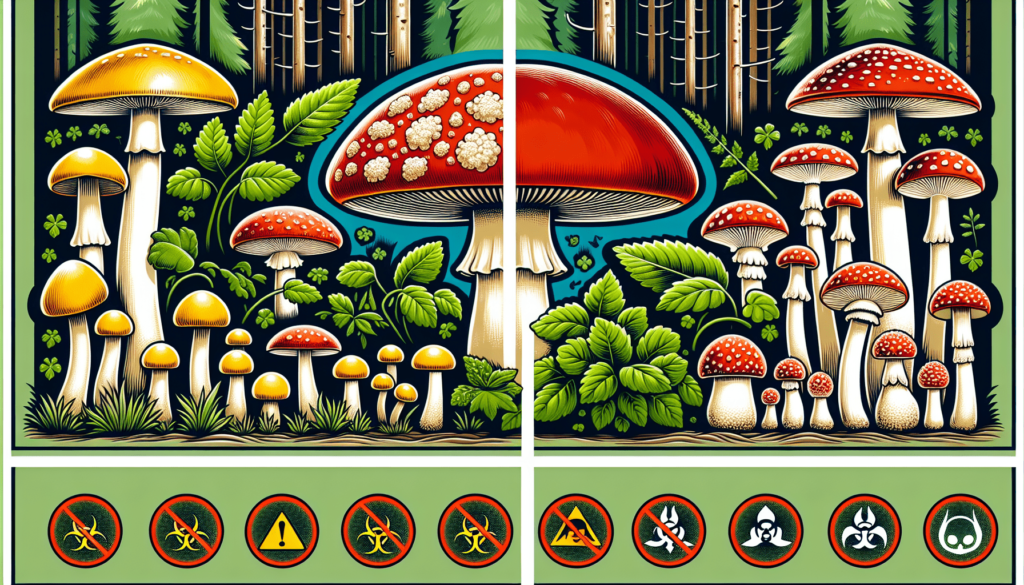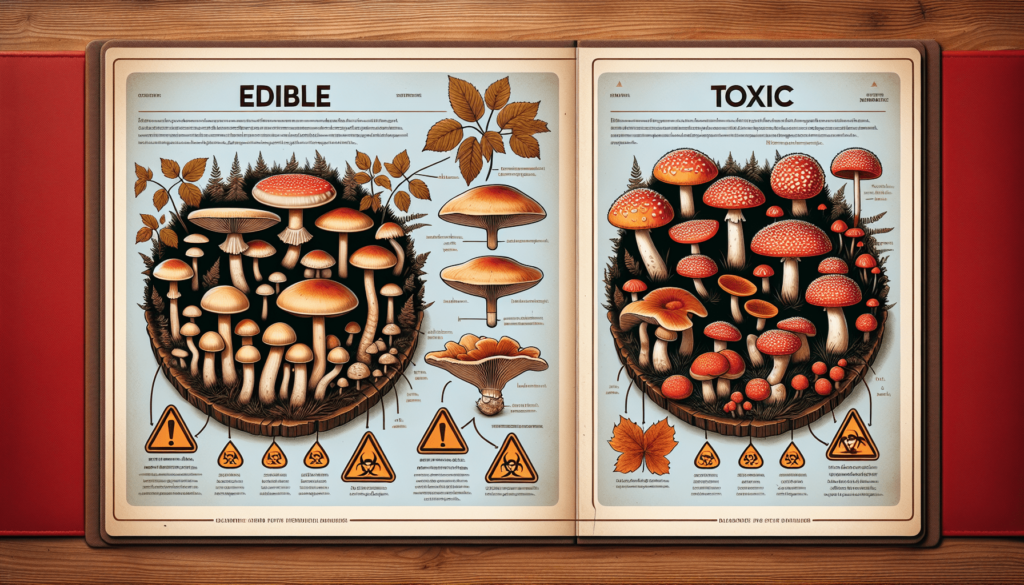In your quest for culinary adventures, it’s vital to have a keen eye when it comes to identifying mushrooms. With their vibrant colors and unique shapes, Amanita mushrooms can be both a delectable treat and a dangerous poison. Before you embark on your foraging journey, it’s essential to know how to distinguish between the edible and toxic varieties of these fascinating fungi. In this article, we’ll explore the key characteristics to look for, enabling you to confidently discern between the potential delights and dangers that Amanita mushrooms hold. So, let’s delve into the enchanting world of Amanitas and learn how to make informed choices when it comes to these magnificent mushrooms.
Distinguishing Amanita Mushrooms
When it comes to distinguishing between edible and toxic Amanita mushrooms, there are several key factors to consider. In this article, we will explore the various physical characteristics and features that can help you identify these mushrooms with confidence. From the appearance of their caps and stems to the presence of a veil and ring, as well as the color of their gills, spores, and volva, we will cover it all. Additionally, we will discuss the importance of smell, bruising, habitat, and seeking expert identification in order to ensure accurate identification.
Physical Appearance
Overall Appearance
Amanita mushrooms are known for their unique and distinct physical appearance. They often have a large, round cap that is supported by a stem. The cap can range in size from a few centimeters to several inches in diameter. Amanita mushrooms can display a wide range of colors, including white, yellow, red, brown, and even black.
Size and Shape
In terms of size and shape, Amanita mushrooms can vary significantly. Some species have small caps, while others have caps that can grow to be quite large. The shape of the cap can also differ, with some Amanita mushrooms having a convex shape, while others are flat or even concave.
Color
The color of Amanita mushrooms can provide important clues for distinguishing between edible and toxic species. Some edible Amanita mushrooms, such as the Amanita caesarea, have a vibrant orange or yellow color. On the other hand, many toxic Amanita species exhibit a classic white color with patches or spots of color on the cap or stem.

Cap and Stem
Cap Texture
The texture of the cap can vary among different Amanita species. Some caps are smooth and shiny, while others may be slightly sticky or have a fibrous texture. It’s important to carefully examine and touch the cap to determine its texture, as this can be a distinguishing feature.
Cap Color
As mentioned earlier, Amanita mushrooms can display a wide range of cap colors. These colors can give important clues about their edibility. While some edible Amanita species have vibrant or distinct colors, many toxic species feature more muted or uniform colors. It’s important to note that color alone is not enough to determine the edibility of a mushroom – it should always be considered in conjunction with other characteristics.
Cap Shape
The shape of the cap can also vary greatly among different Amanita species. Some caps are rounded and dome-shaped, while others may be flat or even have a depressed center. Familiarizing yourself with the various cap shapes can aid in accurate identification.
Stem Texture
Similar to cap texture, the texture of the stem can provide valuable insight into identifying an Amanita mushroom. Some stems are smooth and relatively uniform in texture, while others may be ridged, scaly, or have a fibrous appearance. Examining the stem closely can help in narrowing down potential species.
Stem Color
The color of the stem can also vary significantly among different Amanita species. It can range from being the same color as the cap to being a different color entirely. Paying attention to the stem color can assist in distinguishing between different types of Amanita mushrooms.
Stem Shape
In addition to texture and color, the shape of the stem can also aid in identification. Some stems are straight and cylindrical, while others may be bulbous, swollen, or have a flaring base. Carefully observing the stem shape can help narrow down potential species.
Veil and Ring
Veil Remnants
The presence of veil remnants on an Amanita mushroom can provide valuable information for identification. The veil is a membrane that initially covers and protects the gills of young mushrooms. As the mushroom grows, the veil may break apart or leave remnants on the cap or stem. These remnants can take the form of patches, scales, or even warts. Noting the presence and characteristics of veil remnants can help differentiate between different Amanita species.
Ring Presence
In addition to the veil remnants, many Amanita mushrooms also possess a ring or annulus on the stem. This ring is formed from the remains of the veil as it stretches from the edge of the cap to the stem during the mushroom’s development. Some rings may be visible and intact, while others may have deteriorated or be barely noticeable. Paying attention to the presence and condition of a ring can assist in identifying specific Amanita species.
Ring Location
Observing the location of the ring on the stem is another important aspect of identifying Amanita mushrooms. Some species have a ring that is located near the top of the stem, while others have a ring that is closer to the bottom. The position of the ring can vary and is yet another characteristic to consider when distinguishing between different Amanita species.

Gills
Gill Color
The color of the gills is a critical factor to consider when trying to distinguish between Amanita mushrooms. While some species have gills that are white or cream-colored, others may have gills that appear yellow, pink, gray, or even black. It’s important to note that gill color can fade or change with age, so it’s best to examine the gills on young specimens.
Gill Attachment
Gill attachment refers to how the gills are connected to the stem. Some Amanita species have free gills, meaning they are not attached to the stem and can be easily removed. Others have gills that are attached to the stem or even slightly decurrent, meaning they run slightly down the stem. Examining the attachment of the gills can help in identifying different Amanita species.
Gill Spacing
The spacing between the gills is another characteristic to consider when distinguishing between Amanita mushrooms. Some species have gills that are closely spaced, while others may have gills that are more widely spaced. Paying attention to the spacing between the gills can aid in identification.
Spore Color
Spore Color Determination
Determining the spore color of an Amanita mushroom can be a useful identification tool. To do this, a spore print is often taken. This involves placing the cap of the mushroom, gill-side down, onto a piece of paper or glass overnight to allow the spores to drop and leave a pattern. The resulting color can range from white to various shades of yellow, pink, brown, or even black. Comparing the spore color to known species can help narrow down potential identifications.
Volva
Volva Presence
The volva is a cup-like structure found at the base of the stem in some Amanita species. Its presence or absence can be a helpful clue in identifying a mushroom. Some volvas may be large and well-defined, while others may be small or even completely absent. Carefully examining the base of the stem for the presence or remnants of a volva can aid in accurate identification.
Volva Texture
The texture of the volva can vary among different Amanita species. Some volvas may be smooth, while others may be covered in patches, scales, or even warts. Noting the texture of the volva can provide valuable information for identifying specific Amanita mushrooms.
Volva Color
In addition to texture, the color of the volva can also help in distinguishing between Amanita species. Some volvas may be the same color as the cap or stem, while others may be a different color entirely. Paying attention to the color of the volva can assist in narrowing down potential identifications.
Smell
Odor Evaluation
The smell or odor of an Amanita mushroom can often be a distinguishing characteristic. Some species have a pleasant, mushroomy aroma, while others may have a pungent or even foul smell. Carefully sniffing the mushroom can provide insight into its identity, but it’s important to note that odor alone should not be the sole basis for identification.
Bruising
Color Changes when Damaged
When an Amanita mushroom is damaged or bruised, it may undergo a color change. This bruising reaction can be an important clue for identification purposes. The color change can range from a slight discoloration or staining to a more dramatic color transformation. It’s important to observe any color changes that occur when handling or damaging an Amanita mushroom.
Habitat
While physical characteristics are essential for identifying Amanita mushrooms, understanding their habitat can also be helpful. Different Amanita species tend to have specific preferences for where they grow. Some species are commonly found in forests, while others prefer grassy areas or even sandy soil. Becoming familiar with the typical habitat of certain Amanita species can aid in narrowing down potential identifications.
Expert Identification
While it’s possible to learn about and identify Amanita mushrooms using available resources, seeking the help of an expert is always recommended. With their knowledge and experience, experts can provide accurate identifications and guidance on distinguishing between edible and toxic Amanita species. If you’re uncertain about the identification of an Amanita mushroom, it’s best to consult a mycologist or experienced mushroom identifier to ensure your safety.
In conclusion, distinguishing between edible and toxic Amanita mushrooms involves careful observation of their physical appearance, including cap and stem characteristics, the presence of veil and ring, gill color and attachment, spore color, volva presence and texture, smell, bruising reactions, and habitat preferences. However, it’s crucial to remember that accurate identification can be challenging and seeking professional help is always recommended to ensure your safety when foraging for mushrooms.


No Responses